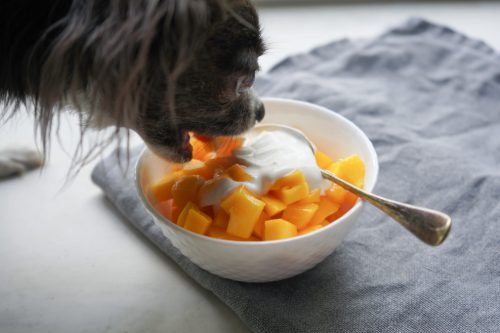Can Dogs Eat Mangos?
Bright, juicy, and packed with vitamins, mangos are a popular tropical treat for humans, but what about dogs? Can dogs eat mangos safely, or are there risks hidden behind that sweet flesh? Pet owners are always on the lookout for healthy snack options that their dogs can enjoy, and fruit often comes up as a go-to alternative to processed treats. This blog will dive into whether dogs can eat mangos, what parts of the mango are safe, how much is appropriate, and what you should watch for when offering fruit to your pet. If you’re wondering whether this fruit belongs in your dog’s diet, keep reading. Keystone Animal Hospital in Bradenton, FL, can help guide you through what’s safe and what’s not for your dog’s digestive health.

Can Dogs Eat Mangos Safely?
Mangos are safe for dogs to eat in moderation and when prepared correctly. The fruit’s soft texture and sweet flavor often appeal to dogs, especially those who enjoy trying new things. Mangos contain beneficial nutrients such as vitamin A, vitamin C, and dietary fiber, which can support immune health and digestion. However, the fruit also contains natural sugars, and overfeeding it can lead to gastrointestinal upset or contribute to unwanted weight gain.
For dogs with sensitive stomachs or existing health conditions, introducing new foods like mangos should be done gradually. While a few small bites can be an enjoyable snack, mangos should never replace a complete and balanced diet. Always cut the fruit into manageable pieces and remove any inedible parts to reduce the risk of choking or intestinal blockage.
Nutritional Value of Mangos for Dogs
Mangos offer a variety of nutrients that can provide some health benefits to dogs when given as an occasional snack. Here’s a closer look at the most notable components of the mango fruit.
Vitamins in Mangos
Mangos are rich in vitamin A, which supports vision and immune health. They also contain vitamin C, an antioxidant that helps reduce inflammation. While dogs naturally produce their own vitamin C, a small dietary boost may still be helpful during stressful times or recovery.
Fiber Content
The fiber in mangos can aid digestion, especially in dogs that need a little help maintaining regular bowel movements. That said, too much fiber can cause diarrhea or bloating, so portion control is essential.
Natural Sugars and Calories
Mangos contain natural sugars, making them a higher-calorie fruit. While the sugar is naturally occurring, it can still affect dogs with diabetes or those prone to weight gain. Small quantities are best, particularly for dogs on a calorie-controlled diet.
Parts of the Mango: What’s Safe and What’s Not?
When answering the question “can dogs eat mangos,” it’s important to clarify that not every part of the mango is safe for dogs. The fruit itself may be okay in moderation, but other components can be harmful.
Mango Flesh
This is the part of the mango that is safe for dogs to eat. Peel the fruit and cut it into small chunks to reduce the risk of choking. Keep servings modest to avoid digestive upset.
Mango Pit
The pit or seed of the mango should never be given to dogs. It presents a choking hazard and can block the intestines if swallowed. The pit also contains cyanide compounds, which are toxic when ingested.
Mango Skin
Though not toxic, the skin of a mango is tough and difficult for dogs to digest. It can cause gastrointestinal discomfort or blockage, particularly in small breeds. Always remove the skin before offering mango to your dog.
How Much Mango Can Dogs Eat?
Moderation is key when it comes to feeding mango to your dog. A few small bites on occasion can be a tasty reward, but regular servings are not necessary or recommended. The right portion depends on your dog’s size, age, and overall health.
Appropriate Portions
Small dogs should have no more than a few small cubes. Medium to large dogs may tolerate slightly larger amounts, but even then, mango should only make up a small percentage of their total daily calorie intake.
Frequency
Limit mango treats to once or twice a week. Rotating fruits and vegetables can help prevent boredom while avoiding overexposure to the sugar content found in mangos.
Dogs That Should Avoid Mangos
Although mangos are generally safe, they’re not the best choice for every dog. Some dogs are more likely to experience issues with new foods, especially when they already have underlying health concerns.
Dogs with Diabetes
Because of the natural sugar content, mangos can raise blood sugar levels. If your dog has diabetes or insulin sensitivity, it’s best to avoid mangos altogether unless your veterinarian has provided guidance.
Dogs with Pancreatitis or Obesity
Fatty and sugary treats can trigger flare-ups in dogs with pancreatitis and contribute to weight gain. For dogs on low-fat or specialized diets, mango is not an ideal treat option.
Puppies and Dogs with Sensitive Stomachs
Puppies still developing their digestive systems, or dogs who are prone to diarrhea, may not handle fruit well. Introducing mango could lead to gastrointestinal upset such as loose stools or vomiting.
How to Prepare Mango for Your Dog
If you decide to give your dog a taste of mango, be sure to prepare it in a way that is safe and easy for them to digest. Here’s how to do it properly.
- Wash and Peel: Start by washing the mango thoroughly to remove any pesticides or residues. Peel the skin off completely, as it’s difficult for dogs to digest.
- Remove the Pit: Cut the mango away from the pit and discard the seed. Be sure no fragments remain in the fruit that could be accidentally swallowed.
- Serve in Small Pieces: Cut the fruit into bite-sized cubes appropriate for your dog’s size. These smaller portions reduce choking risk and make it easier to control how much they eat.
You can offer mango as a fresh snack, freeze the pieces for a summer treat, or mix a few chunks into their food bowl occasionally as a topper.
When to Contact Your Veterinarian
Even with safe foods like mango, it’s possible for some dogs to experience unexpected reactions. If your dog shows signs of discomfort after eating mango, such as vomiting, diarrhea, or changes in appetite, it’s time to contact your veterinarian. Keystone Animal Hospital is always here to support your pet’s health and help you make informed dietary choices. Some signs that require immediate attention include:
- Difficulty breathing or signs of choking
- Persistent vomiting or diarrhea
- Signs of an allergic reaction such as itching or swelling
- Lethargy after eating mango
If you have any questions about your pet’s diet or notice concerning symptoms, call us at (941) 741-8445 or request an appointment. It’s always better to be safe than sorry when introducing new foods.
A Tropical Treat With Guidelines
So, can dogs eat mangos? Yes, but with some important considerations. This fruit can be a safe, vitamin-rich snack when fed in moderation and prepared properly. Always remove the skin and pit, keep portions small, and limit how often you offer it. While mangos can be a tasty reward, they should never take the place of a balanced diet. Keystone Animal Hospital in Bradenton, FL, encourages pet owners to make mindful decisions when it comes to their dog’s diet. If you’re ever unsure about a food or treat, our team is happy to offer guidance. Call (941) 741-8445 today or request an appointment to speak with our veterinary team about your pet’s nutritional needs.
